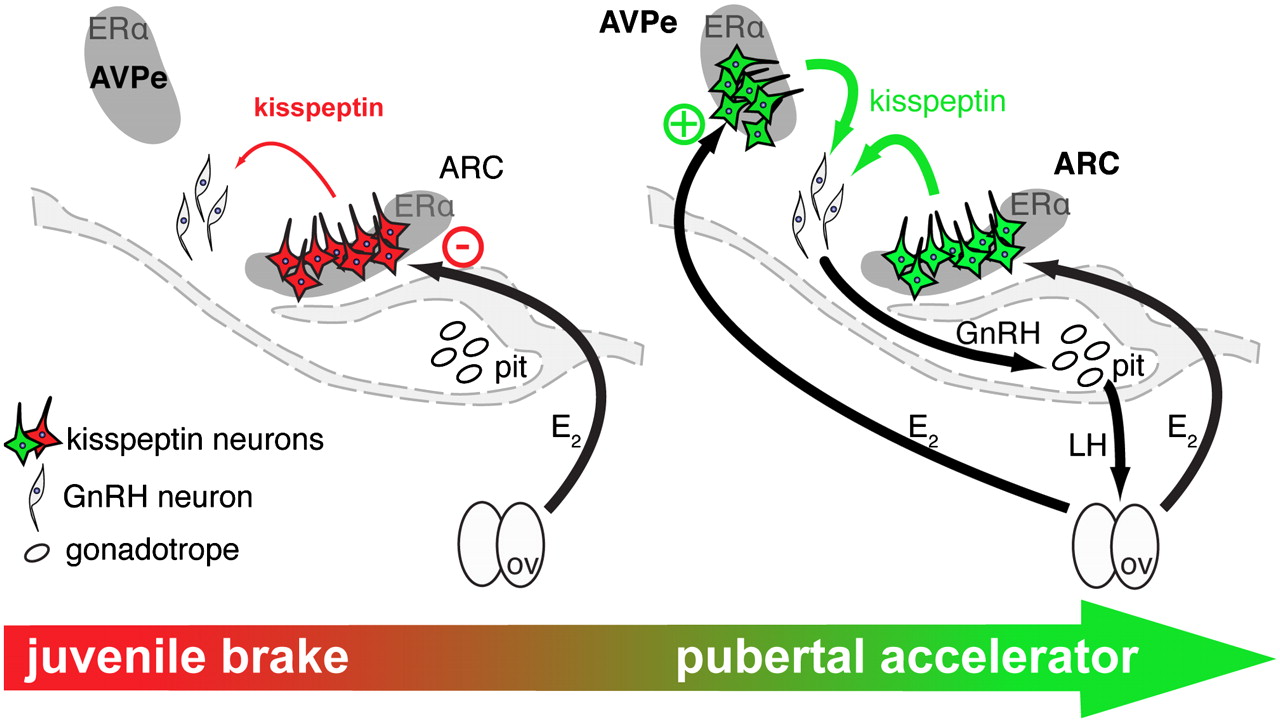Biology of Reproduction, lecture on Labor and Parturition
XXIV. Labor and Parturition back to XXIII. Pregnancy
A. Maturation of the fetal adrenal and adrenal axis
1. fetal adrenal now has zones: outer now makes cortisol
inner makes DHEAS
a. CRH stimulates ACTH, which stimulates cortisol (F)
from the fetal adrenal
b. CRH regulates DHEAS, E3 and F levels during pregnancy
i. mostly chorionic CRH
(levels rise throughout pregnancy)
(1) CRH levels predict the timing of labor
(a) Ý [CRH] ® early delivery
¯ [CRH] ® late delivery
(2) CRH also acts directly on uterus and cevix
(a) influencing PGs and OT
(b) CRH-R early in pregnancy ® ¯ contractions
different CRH-R later ® Ý contractions
2. cortisol promotes continued CRH secretion
a. positive feedback
3. F also helps convert P to E in the placenta
a. Ý adrenal cortisol (sheep) or androgens (humans)
i. F ® Ý P450C17b and 17-20 lyase: P ® E2
or
ii. CRH ® Ý F ® Ý CRH ® adrenal
® Ý adrenal DHEAS + androstenedione ® E2
a. P levels fall at the end of pregnancy and E levels rise
4. E/P ratio changes, becomes > 1
a. CRH, F, PGs, E/P reach threshold
5. Ý E/P ratio causes:
a. OT receptors to rise in the uterus
i. labor begins
ii. P inhibition of uterine contractions is now limited
b. increased neural feedback from the cervix and uterus
i. stimulates OT release
(1) neuroendocrine reflex
c. increased production of OT
d. increased production of PGF2a
e. E treatment late in pregnancy speeds up onset of labor
6. Cortisol levels in fetal plasma and amniotic fluid
rise late in pregnancy
a. Delayed newborns commonly have underdeveloped
adrenals, lower than normal cortisol,
and the mothers have low E levels
b. Premature newborns tend to have enlarged adrenals
c. maternal stress (chronic ® Ý CRH + F) may
stimulate premature labor
d. injection of ACTH or cortisol will stimulate
labor in other animals (e.g. sheep)
B. Oxytocin (OT = Oxy)
1. Labor begins with an increase in OT-R not in OT
a. Ý OT-R stimulated by Ý E/P ratio
i. directly by cortisol or CRH?
2. OT stimulates Uterine contractions
a. OT (or Pitocin) will induce labor
i. CRH and E potentiate OT contractions
ii. Ethyl Alchol or other OT inhibitors will delay labor
b. acute stress ® Ý Epi and NE block uterine contractions
3. Uterine contractions = Fetal Ejection Reflex stimulate OT release
a. also stimulated by Ý E/P ratio
4. OT stimulates uterine PGF2a production
a. CRH ® Ý PGs
C. Prostaglandins (PGs)
1. PGF2a stimulates uterine contractions
a. PGF2a or PGE2 administration will initiate labor
b. aspirin or other anti-prostaglandins delay labor
2. burst of PGF2a with each contraction during labor
a. contractions stimulate PGF2a secretion
3. Ý E/P ratio stimulates uterine PGF2a production
D. Fetal Ejection Reflex
1. stimulation or distention of cervix, uterus, or vagina
results in neural feedback turning on the secretion of OT
a. neuroendocrine reflex (see 2 & 3)
b. stimulating b2-adrenergic receptors
in myometrium blocks contraction
i. Epi and NE from adrenal medulla during acute stress
(1) lamaze and Bradley methods utilized this idea
(a) focusing on breathing style
and rhythm reduces nervousness
(b) thereby ¯ Epi and NE
2. Sensory Afferents to the brain
a. cervix/uterus ® spinal cord ® brain
b. stimulate Neurohypophysis
i. release OT
(1) OT stimulates PGF2a release
3. OT + PGF2a increase uterine contractions
a. positive feedback loop
i. increased contraction amplitude and frequency
ii. culminates in birth
